Monday, November 3, 2008
Felt Coffee Cozy
Cute Coffee Cozy on this site: http://www.amberdusick.com/woodmouse_loves_crafts/2007/11/tutorial-felt-c.html
Saturday, October 4, 2008
Reversible Super Hero Cape by Jham
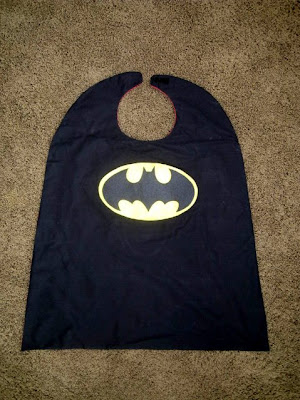

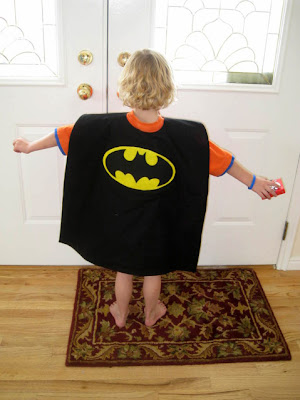
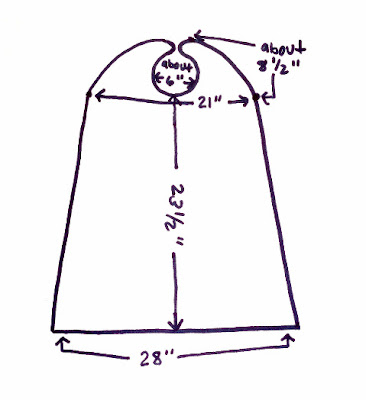
I used about a 1/4" seam allowance and left an opening at the bottom big enough for my hand so I could turn it right side out. Then I used a little piece of stitch witchery to close the opening without showing any stitching. When I put the velcro on I just remembered to put one side on one color and the other side on the other color (before I stitched around the edgs) to keep me from messing up.
Wednesday, September 10, 2008
Chart for Sizing DOWN a Pattern by CarlaC
Origianally posted by LouiesMama (CarlaC ) Thank you Carla!!!
http://www.disboards.com/showpost.php?p=27480030&postcount=1950 My patternmaking book only goes down to size 3, so I used the size charts
in "Simply the Best Sewing Book" by Simplicity.
Their measurements for each size (chest/waist/hip) in inches are as
follows:
0.5 - 19/19/20 (six months)
1 - 20/19.5/21
2 - 21/20/22
3 - 22/20.5/23
If you are using a commercial pattern, you might want to check the
measurements they use for each size just to make sure they correspond (if the
measurements aren't on the pattern, you can find them in the pattern book or on
the company's website). So here are the numbers I came up with:
Size 3 down to size 2 - scaling set to 95%
Size 3 down to size 1 - scaling set to 91%
Size 3 down to size 0.5 - scaling set to 86%
Size 2 down to size 1 - scaling set to 95%
Size 2 down to size 0.5 - scaling set to 91%
Size 2 down to size 0 - scaling set to 86%
Size 1 down to size 0.5 - scaling set to 95%
Size .5 down to size 0 - scaling set to 90%
I based the newborn size 0 on a chest measurement of 18" (this one is for
you, T ). So it seems like (at least for the tiny sizes) the general rule of
thumb is:
Shrinking 1 size - scaling set to 95%
Shrinking 2 sizes - scaling set to 91%
Shrinking 3 sizes - scaling set to 86%
Monday, September 8, 2008
Percentages for scaling up a pattern! By CarlaC (LouiesMama)
Origianally posted by CarlaC (LouiesMama)
I was looking at the size charts in my patternmaking textbook, and it seems
like the larger "tween" sizes increase pretty proportionally. I did the math
to
get the differences in the sizes so that the pattern pieces could be
scaled up
on a copy machine.
to go from an 8 to a 10, scale up
103%
to go from an 8 to a 12, scale up 106%
to go from an 8 to a 14, scale
up 110%
to go from a 10 to a 12, scale up 103%
to go from a 10 to a 14,
scale up 106%
to go from a 10 to a 16, scale up 110%
You'll want
to go to a place like Kinko's that has nice machines so you can
adjust the
scale to whatever you want, and also so you can select a larger paper
size
(I think you can go up to 11X17 in most machines).I haven't tried this
personally (I just do the scaling in my drawing program), but these are the
percentages I would use. This should work for most patterns (not just mine)
that
are free-fitting like the peasant top/dress. With more fitted styles,
keep in
mind that as girls develop, the hip/waist ratio changes, and also
the bustline
changes. So for something like the a-line, scaling up might not
work. Boys are
easy - they stay pretty much the same until they either get
big muscles or a
beer belly !
Tuesday, May 27, 2008
Adding Pictures to the Group Photobucket account
You will need your own personal Photobucket account to add pictures to the Group Album.
Click on this link found in the first post of our thread and put in the password you will also find there.
If you are not signed into your own personal Photobucket account, do so now.
After you sign in, it should take you back to the our Group Album. If not, just put in the address again.
To the left side of the screen, underneath where it says, "Where's This Album": click on "Add to Favorites".
When you log in to your account the next time, there will be a category called "Favorites" on the left side of your personal page screen, our group show up there. Just click it, and VOILA! you are at the group page! (you may have to put the Group password in again)
OK, so now you are all logged in, time to add some pictures to the Group Album!!!
At the top of the page, you should see this:

Fist, decide where you want to transfer your pictures from. If you already have the pictures in your own personal Photobucket account, you can just transfer them to the group account from there.
Click on the dot that says, "My Album"
A list of the albums in your personal account will appear in the drop down window.
Click on the album name where the pictures you want to transfer are located.
Itybitty little thumbnails will appear in the box:

Click on the "+" next to the picture you want to add to the group album (the pictures will stay in your personal account as well)
When you have clicked on every picture you want to add, click "copy files" and wait for the pictures to transfer, very easy!
To Copy the files from your computer, you would just click on "my computer" a pop up will appear allowing you to chose the pictures from your computer.
To select multiple files, hold down the "CTRL" button on your computer.
When you have selected the pictures, click "open"
The pictures will then be transferred to the group album.
You can also move the pictures from a URL, that's pretty simple, so I won't go into detail.
Now that your pictures are on the Group Album, you will need to tag them.(please, pretty please with sugar on top, tag your pictures :-) )
If you look to the left of the main page, you will see a list of tags that we have already made. Try to use the ones that we have already made, if they fit. Such as if you have a Tinkerbell outfit, please use the tag "Tink" instead of making a "Tinkerbell" tag.
If there is no tag for your outfit, feel free to create one that fits.
We are trying to tag the pictures with the character and pattern. If you look at the tags, you look at the list of tags, you will get a feel for what we are doing. Each picture can have up to 20 tags, so feel free to use several.
To actually tag the pictures, Click on "Add Tags & Descriptions" which is just above all the thumbnail pictures. This will open up a new page.Here, you can put a Title, description and tags in. Click on "Click to add Tags"This will pop up only, it will be your picture, and not Heather's ;-):

You will notice a little box over your picture. If you want to tag different parts of your picture with separate tags, just move the box to the part you want to tag. (this is good if you have several different outfits in your picture)
Type in the name of the tag in the box and click "save"
You can then repeat the process until you have added all the tags you want for that picture.
Repeat for the next picture.
At the end of the page, click "Save and Continue"
If you accidentally create a duplicate tag, do to spelling or capitalization differences etc... you can click "remove" next to the tag and retype it.
If you accidentally create a duplicate tag, do to spelling or capitalization differences etc... you can click "remove" next to the tag and retype it.
Tuesday, April 22, 2008
How to Tie a Perfect Bow
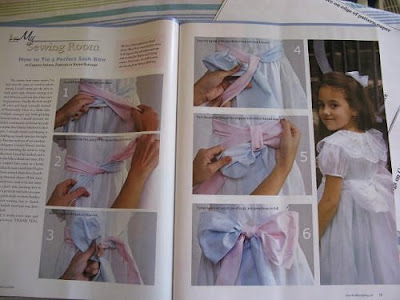
How to tie a proper bow (with fully lined ties)
1.)Facing dress, take each tie in opposite hand- left tie in right hand, etc
cross the left tie over the right tie
2.)wrap it under right tie and pull up and to the right
3.)gently, but firmly take right tie (that is now on the left) and form "bent bunny ear"
4.)take left tie (dangling over on right side) and pull down and to left to wrap around bunny ear,
5.)as you come up behind bunny ear pull thru hole and to to the right-
adjust and tighten.
6.)So the right tie ends up at the left side of bow and left tie becomes right side of bow.
6.)So the right tie ends up at the left side of bow and left tie becomes right side of bow.
Thursday, April 17, 2008
Sock Curls by Castle Creations
The sock curl is really easy. After washing your daughters hair, dry it until it's just barely damp, put in some hair product of your choice, gel, mousse, whatever...I usually use nothing. And you take a bunch of socks, and wind sections of hair around the socks and when you get up to her head, you just tie the ends of the socks together. It reminds me of when my grandmother used to do rag curls on us when we were little. The socks are great, because they absorb the excess dampness in the hair, and they aren't too bad to sleep on. In the morning....wa-la, curly hair...
How much should I charge for my items? by Ediebeedieboutique
This is how I determine the cost of my clothing as well, although you need to account for profit as well. This is different from labor. Pricing your clothing this way, you will always be able to account for using more expensive fabrics or if you make a difficult design that takes more time to complete. See below:
Cost Plus Pricing
The best way to determine the prices you will charge for your products or services is to use a cost plus pricing formula and combine this with your overall pricing strategy. To accomplish this, you have to figure out your fixed operating costs, your variable costs associated with the delivery of services, the manufacturing of products, or the wholesale costs of products, and add a profit. The formula therefore is:
Variable costs + Fixed costs + Profit = Selling price.
Assume you sell services. Just remember that the following information can also be used to determine cost plus pricing for products. As a rule of thumb, labor costs generally represent the largest share of expenses for service providers. So the first step is to figure out how much you want to earn per hour. You should base our decision on three factors: How much money you need to earn to pay your personal expenses? What is the industry average for the job? Do you have a premium if the service you provide is highly specialized or risky?
Once you have determined how much per hour you want to earn, the next step is to calculate your fixed costs, which are business expenses that do not fluctuate regardless of the number of sales you make, such as the telephone, rent, and insurance. Use the attached worksheet to determine your fixed operating costs.
The next step is to determine the costs incurred in the delivery of the service, which is referred to as variable costs. For instance, if you operated a dog grooming service, the costs to purchase shampoo and grooming supplies for each dog groomed would be the variable costs. The next step is to calculate and add a profit. Every business needs to generate a profit in order to stay in business and stay competitive in the market place. Most small business owners use a percentage to calculate a profit on each job, such as total costs plus 20 percent. The final step is to tie it all together. The formula used to arrive at a selling price is to:
1. Multiple your labor rate by the number of hours to complete the job.
2. Add fixed expenses.
3. Add variable expenses.
4. Multiple the total of the three by your desired profit margin.
5. The total is your selling price.
For the example below, we will assume that fixed business expenses are $1,000 per month, and there are 160 billable work hours each month; $1,000 divided by 160 hours equals $6.25 per hour fixed expenses, and that the total job required 25 hours to complete
Labor rate, $20 per hour x 25 hours = $500.00
Fixed expenses, $6.25 per hour x 25 hours = $156.25
Variable expenses for the job = $150.00
Total = $806.25
Profit 20% = $161.25
Selling price = $967.50
Cost Plus Pricing
The best way to determine the prices you will charge for your products or services is to use a cost plus pricing formula and combine this with your overall pricing strategy. To accomplish this, you have to figure out your fixed operating costs, your variable costs associated with the delivery of services, the manufacturing of products, or the wholesale costs of products, and add a profit. The formula therefore is:
Variable costs + Fixed costs + Profit = Selling price.
Assume you sell services. Just remember that the following information can also be used to determine cost plus pricing for products. As a rule of thumb, labor costs generally represent the largest share of expenses for service providers. So the first step is to figure out how much you want to earn per hour. You should base our decision on three factors: How much money you need to earn to pay your personal expenses? What is the industry average for the job? Do you have a premium if the service you provide is highly specialized or risky?
Once you have determined how much per hour you want to earn, the next step is to calculate your fixed costs, which are business expenses that do not fluctuate regardless of the number of sales you make, such as the telephone, rent, and insurance. Use the attached worksheet to determine your fixed operating costs.
The next step is to determine the costs incurred in the delivery of the service, which is referred to as variable costs. For instance, if you operated a dog grooming service, the costs to purchase shampoo and grooming supplies for each dog groomed would be the variable costs. The next step is to calculate and add a profit. Every business needs to generate a profit in order to stay in business and stay competitive in the market place. Most small business owners use a percentage to calculate a profit on each job, such as total costs plus 20 percent. The final step is to tie it all together. The formula used to arrive at a selling price is to:
1. Multiple your labor rate by the number of hours to complete the job.
2. Add fixed expenses.
3. Add variable expenses.
4. Multiple the total of the three by your desired profit margin.
5. The total is your selling price.
For the example below, we will assume that fixed business expenses are $1,000 per month, and there are 160 billable work hours each month; $1,000 divided by 160 hours equals $6.25 per hour fixed expenses, and that the total job required 25 hours to complete
Labor rate, $20 per hour x 25 hours = $500.00
Fixed expenses, $6.25 per hour x 25 hours = $156.25
Variable expenses for the job = $150.00
Total = $806.25
Profit 20% = $161.25
Selling price = $967.50
Monday, April 14, 2008
Easy Gathers by candicenicole19
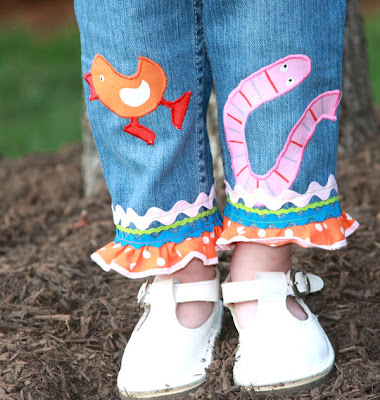
If you want a nice even gather and you are not going for a SUPER twirl then what i do is crank up the tension all the way (Mine is 9) and the stitch length (Mine goes to 5) and slow down the machine to the slowest speed and you will have an awesome even gather! Works great for twirl skirts and jumper dresses! lol, It is my perferred method! Here is the only close up I can find of this method. it is a ruffle at the bottom of a pair of pants but you can see it gathers Nice at least!
Hello Kitty Button Shirt by Mytwotinks
A couple of people have asked how I attached the buttons on this top so here are my very simple instructions!1.) I traced the shape of her head and marked the eyes, nose and center of the bow onto the shirt.2.) I used a teeny tiny thread of glue to attach the buttons. I started with the bow and then did the little bit of ear that shows behind that and then the rest of the head and the eyes and nose.3.) When the glue was dryish I used embroidery floss and attached the buttons.Super easy and fast! I think the whole thing took less than an hour.
Sunday, April 13, 2008
Patchwork Twirl by candicenicole19
What I do is use 6X6 squares (My dd is a size 2T so manybe smaller for your DD) I start with the top layer and usE 6 squares for the waistband, put to the sideThen I use 12 for the next row and 24 for the row after that.I fold the top layer to make a casing for my elastic and stitch into place. Then I gather the other rows using a basting stitch and pin the first l;ayer to the top of the second and sew, then serge and top stitch.I repeat with the second layer by attaching the 3rd layer to the top of the bottom of the second layer, sew, serge, topstitch add a ruffle at the bottom, add the elastic sew the casing closed and you are finished if you need any tips, PM me and I will help you! Hope it helps some! lol
Friday, April 4, 2008
The Bestest Applique Tutorial EVER! (By Heathersue, my baby sister)
To Download the E-book of this tutorial, please click the link below:
I’m by no means an applique expert, but this is the way I do appliqués. I hope this tutorial will help any beginners out there that are confused by how this whole process works!
Finding and preparing an image to applique:
First, you need to choose a picture that you want to use for your applique. There is no need to purchase an “appliquepattern”. I like to search google images or photobucket to find the picture I’m looking for. If you find a picture youlike, just save it to your computer. Next, you can resize it with photo editing software to the size you’d like. You can also use images from children’s books, coloring books, etc… You can either trace these images, or use your scanner to put them onto your computer and then print them. For this particular project, I’m going to use an image that is on a piece of fabric (scanned the fabric, then enlarged the part I wanted in Corel Paint Shop).
Once you have the picture you want to use, print it out.

If you don’t want the picture to be reversed when you applique it onto the shirt, trace around the lines that you want to use on your applique with a permanent or some kind of dark marker that will show through the paper. When you’re finished tracing the lines you want to use, flip the paper over and you’ll have the lines you want to use, without all the extra details that you don’t. You can go over the lines again if they are too light.

If you don’t mind the picture getting reversed onto your finished garment, go ahead and just trace the lines on the right side of the picture with a dark marker and use the right side for the following steps. Cutting your applique pieces: Next, you’ll need to get out your heat ‘n bond LITE paper (do not use ultra, only Lite). Put the paper over the side of the image you have determined in the last step.

Be sure that you place the smooth side of the heat ‘n bond up. You’ll need to decide which parts of the picture you want to do in different fabrics. After you have decided this, do each piece of the drawing that will be in a different fabric, on a separate part of the heat ‘n bond. You don’t want to just trace the picture exactly as it is, or you will not have room for overlapping.
 Next, you’ll need to decide in which order you want to layer each piece. For this example, I wanted the sundae glass and the top scoop to be in the bottom layer, the straw to be in the middle layer and the middle scoop to be the very top layer. The bottom and middle layers will have to have an extra “seam allowance” so we can over lap other layers over them. So, I drew about ¼ inch extra seam allowance on each surface that will be overlapped with another piece.
Next, you’ll need to decide in which order you want to layer each piece. For this example, I wanted the sundae glass and the top scoop to be in the bottom layer, the straw to be in the middle layer and the middle scoop to be the very top layer. The bottom and middle layers will have to have an extra “seam allowance” so we can over lap other layers over them. So, I drew about ¼ inch extra seam allowance on each surface that will be overlapped with another piece.
In this instance, that was the top of the sundae glass, the bottom of the top scoop, and the bottom of the straw. The top layer will not have any extra edge on it because it will not be going underneath any other piece. Now, cut the pieces of heat ‘n bond out, leaving plenty of extra room around the pictures you have traced (don’t cut right on the lines!).

Next, get the different fabrics you want to use for the applique and iron all of the wrinkles out of them. After that, set your iron for the setting as directed on the heat ‘n bond (about a 2 on my iron). Place the cut pieces of the heat ‘n bond on the WRONG side of the fabric and iron them on . Now, take your scissors and cut out the fabric along the lines you have traced onto the heat ’n bond. It’s easier to cut nice straight lines since you left the extra heat ‘n bond around the edges.

Piecing together your applique and fusing it to the fabric:
Next, you will assemble the applique onto your Teflon pressing sheet. I bought the one shown below at JoAnn for $7.99. The pressing sheet is the large plastic sheet under the bag in the photo.

Put the picture you are working with underneath the pressing sheet (the sheet is see-through).

Peel the paper backing off of the fabric pieces and lay them on the pressing sheet. You can secure each piece in place with the iron as you go (in an up and down motion, don‘t slide the iron around like you do when you‘re smoothing wrinkles). Make sure you start with the bottom layer and work your way up. Overlap the pieces at the “seam allowances”.

When you’re finished with this step, you’ll have a good idea of what your applique will look like. You can move the pieces around until you’re happy with how it looks. Then, give it a final press with iron. Wait until it cools, and then carefully peel the applique off the sheet, trying to keep all the pieces fused together. The really cool part about the Teflon pressing sheet is that the applique will peel right off of it, but the heat ‘n bond will still work when you iron it onto the garment.

Next, prepare the fabric that you’re going to applique on. Iron all of the wrinkles out if it. Stabilizer will help to keep the fabric from puckering around the edges of the applique. I like the Sulky iron on, tear-away, stabilizer. Cut off a piece of stabilizer a little bigger than your applique and then iron it onto the WRONG side of the fabric. Don’t worry about it if the piece seems too big, you will be tearing away the excess when you’re done.

Now, turn the fabric with the attached stabilizer over so you’re working with the right side. Place the applique on the fabric where you want it to go. Make sure you have it centered and that you’ve taken the seam allowances of the finished garment into account. Iron it on, following the directions on the heat ‘n bond.

Sewing it on your garment/fabric:
Now you’re ready to start sewing! The best kind of foot to use for applique is an applique foot like the one pictured below, or something similar. Try to use thread that matches each color you are using in the applique. If you use a different color to outline, it is easier to see the mistakes! Some people use a different color bobbin thread, but I haven’t mastered that yet. My machine always tends to pull the bobbin thread up to the top, so I use matching bobbin thread and top thread. I like working with polyester thread for applique. I don’t recommend metallic threads for applique- they break!! Start with the bottom most layer and work your way up to the top piece. In this example, I could either start with the sundae glass or the top scoop, since they are both in the bottom layer. Begin by anchoring your thread. I have found that the best way to do this is to set your machine on zig-zag, with a setting of 0.2 or 0.3 for the stitch length and 0 for the stitch width. Here’s what it looks like on my Brother CS6000i machine.
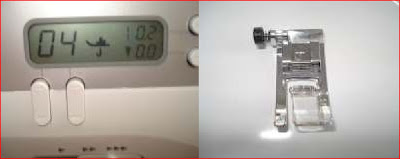
With your needle right on the edge of the applique, where you want to begin sewing, sew 3-4 stitches forward and then
*3-4 stitches back to anchor your strings. (see picture at the bottom for backstitch button)
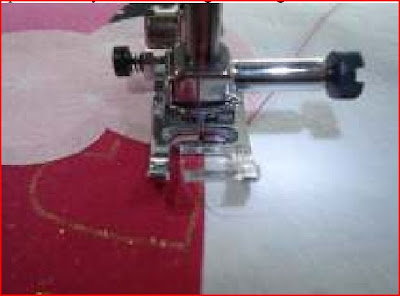
Then, reset your width to approximately 4.0 and leave the stitch length at 0.2 or 0.3. Raise your needle and then make sure it will come down precisely on the outer edge of the applique, when the needle is in the right hand position of the zig-zag stitch. Stitch a few stitches to make sure it’s landing right on the edge. Now, just try to follow the edge of the applique.
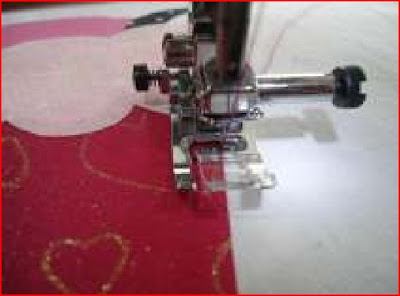
Now, what do you do when you come to a corner, or a turn?

This is where it gets tricky. You need to make sure you are turning your fabric the correct direction, with the needle in the correct position. In the above photo, you’ll need to lift the presser foot, with the needle in the down position, on the left hand side of the zig zag. Then turn your fabric to the right. You’ll leave your needle in the right hand position if you’re turning the other way. In the picture below, I went to the end point of where I wanted to stop, stopped with my needle in the down position on the right hand side and then turned my fabric right and continued zig-zagging.

This next photo shows what happens if I would have stopped with the needle in the left hand position and then turned my fabric right. You can see that it doesn‘t make a point on the corner if you leave the needle in the wrong position before turning.:

This same rule applies if you’re going around a curve. Here’s a curve where I stopped the needle in the wrong position before I turned my fabric:

This is something you can’t really learn by reading it. You just have to practice. The correct needle position and turning technique will become second nature with practice. When you’re done going around the first layer, set your stitch width to 0 again and backstitch 3-4 stitches and go forward 3-4 stitches to anchor your thread again. I like to clip my threads at this point. I cut them very close to the garment. If you anchor them as shown, they shouldn’t unravel.

Change your thread to the color of the next layer and go around that.
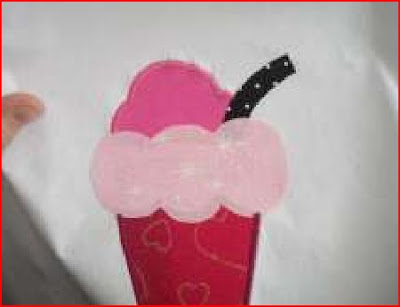
Continue doing this until you finish the top layer of your applique.
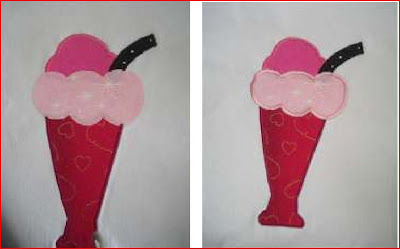
Now, turn the fabric over and rip off the excess stabilizer:
 YOU’RE FINISHED!!!! Except for the little task of actually sewing the clothing together, that is!
YOU’RE FINISHED!!!! Except for the little task of actually sewing the clothing together, that is! Miscellaneous tips:
*If you happened to try to iron your stabilizer on the wrong side and it got your iron all gunked up, just get out an old towel and a sheet of fabric softener. Put the fabric softener on top of the towel and run your iron over it a few times. It will generally take the gooey stuff right off. Not that I have ever done that or anything ;o).
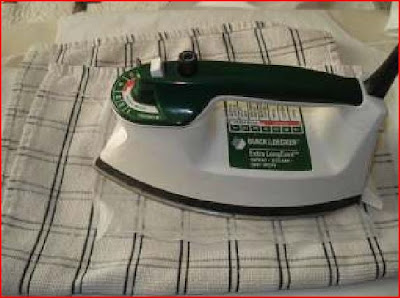
*Lots of people will tell you to go slow and take your time when appliquéing. But, I seem to do better looking appliqués, with smoother lines, when I go fast! LOL! Just experiment and see what works best for you.
*If you’re going to applique a face, it’s best to hand-embroider the eyes/nose/mouth. It’s really hard to get a face to look good with machine applique, especially if you’re a beginner. Here’s a link that has videos of the different embroidery stitches. http://www.needlenthread.com/2006/10/video-library-of-hand-embroidery.html I like the whipped back stitch for outlines and the satin stitch for filling in. Here are some examples of hand-embroidered faces:

If the character you’re appliquéing has larger features, like the ones below, it’s a little easier to use the machine and appliqué the faces. I also like to “cheat” by using buttons and such for some of the smaller features, like the turkey’s eye below. Be creative!

*When choosing fabrics for your applique, try to stick with patterned fabric (thanks for that tip, LisaZoe!). It doesn’t fray like a solid fabric will and it adds more texture to your applique. Remember that you can also use the back of the fabric for a different look.
*If you can’t find the right picture to use as a template for your applique, you can capture a picture from a movie. I like to use the program Intervideo WinDVD for this. The program came with my computer. It has a little camera on the menu while you’re watching the movie. You can just click the camera at the spot you wish to take a picture. It will take the picture and you can save it as a file. Then, use it as an applique template. This is how I got the Cinderella picture above.
*For more applique and other sewing tips, check out Teresa joy’s bookmarks: http://www.mybookmarks.com/public/teresajoy/#current

*The backstitch / reverse button usually looks like an arrow pointing backwards, as in #2 of the picture above.
Thursday, April 3, 2008
Wednesday, April 2, 2008
Tutu by Flea
How I do mine is I sew a length of ribbon to each end of the elastic (enough for waist measurement) - I use non roll medium width elastic - then I cut the tulle into strips depending on the length I want it - measure waist to whereever you want it to fall - double then add 2 inches.I've made lots now so I just gather and sew but if you want to just loop the tulle around the elastic in the colour pattern you like making it quite full then I do a 3 stage zig zag while slightly stretching the elastic. I find this makes a nice flat waistband and there are no knots to come undone.
Tuesday, March 25, 2008
Pettiskirt by LouiesMama
I've never actually seen a pettiskirt in real life, so I just sort of guessed on the dimensions. Basically, the one I made is 2 layers, 3 tiers each (2" ruffle tier and two 6" tiers) with a ribbon waistband. I just cut 5 yards of tulle (I think it was 60" wide, but I'm not positive) into 6 inch and 2 inch strips with the rotary cutter. I then set the ruffler to ruffle to a factor of about 5, and ruffled the 2" strips onto 2 of the 6" strips. It was really time consuming because the edges of the two strips kept trying to stick together. Plus, the ruffler kept on jamming for some unknown reason (DH told me to go up and watch my own video ). I just kept ruffling and ruffling until it looked like the bottom tier would be full enough. Then I attached the bottom tiers to the top tiers, and the top tiers to the waistband.I used a really soft bridal tulle, but I'm really wishing I had gone with chiffon. The ends tend to stick and it just doesn't seem to hang right. Plus, it is too sheer at the top. It is for Louie's little friend Abbey (the cute redhead in the easy-fit and raglan eBooks), and I think it will be fine for photos and play, especially if she wears leggings with it .Anyway, it wasn't overly hard, just very time consuming (I probably have 4 or 5 hours into that one). If you are going to attempt one, make sure that you are very good friends with your ruffler attachment - LOL!
Original post here: http://www.disboards.com/showpost.php?p=24005356&postcount=3403
Sunday, March 23, 2008
Dolly Tights By LivNDisney
Ladies knee highs!!!!!Walmart sells 1 pair of ladies knee highs (in the little egg) for .39. 1 egg equals two pair of tights. Walmart usually has some really fun colors.Remove 1 knee high and turn it inside out. Smooth out the wrinkles. The top (open part) becomes the waist. Make a small mark in the middle of the stocking about 5 inches from the top of the waist. (This will be the "crotch")
 Starting at the toe stitch up the leg from one mark to the top mark. Stitch from the top mark down the other leg. Cut up the middle between the two stitch lines. (Be careful not to cut the stitches or cut too close to the stitches) You can serge the inside seam but it is not necessary. Trim as needed and turn rightside out. (You can also "shorten" the legs of the tights by sewing across the toes)Once I had made a few pair of these, I moved on to using "trouser socks". They are a little more costly, but they tend to be "thicker" and a little more durable. They also have some neat patterns that look really cute as tights. Just remember to only use socks with no heel.
Starting at the toe stitch up the leg from one mark to the top mark. Stitch from the top mark down the other leg. Cut up the middle between the two stitch lines. (Be careful not to cut the stitches or cut too close to the stitches) You can serge the inside seam but it is not necessary. Trim as needed and turn rightside out. (You can also "shorten" the legs of the tights by sewing across the toes)Once I had made a few pair of these, I moved on to using "trouser socks". They are a little more costly, but they tend to be "thicker" and a little more durable. They also have some neat patterns that look really cute as tights. Just remember to only use socks with no heel.
Fold the stocking in half long ways. Make a mark 1/2 inch from the middle on either side of the middle. These are the feet.
Friday, March 21, 2008
Jham's 30 Minute Skirt (including math time)
Here is my easiest ever skirt (30 minutes including math!), I'm sure some of you have made it before, it is not exactly genious. And here is the "recipe":Figure out how long you want it (in this case it was 20"), subtract 3" for the border strip, then add 1 3/4" for casing and seam allowances and cut that length the width of your fabric (45") so in this case I cut 18 3/4". I cut a strip of the border fabric 6 1/2"X 45", folded it in half, wrong sides together. I ironed it, then laid it on top of the right side of my big piece, raw edges lined up, then stiched a 1/4" seam allowance, serged my seam, turned serged edge up towards main body of skirt and topstitched it, then stitched the one side seam. I then serged the top edge of the fabric, or you can turn it under 1/4", then I turned it under about another 1 1/4 inch, then stitched around making a (1") casing, leaving an opening for my elastic, then threaded through some 3/4" elastic, sewed the ends together and stitiched my casing closed. Now I just need to make the peasant top to match! I like how it turned out! I only needed a tad over 1/2 yard of fabric for the skirt (could've made it with 1/2 yard) and 1/4 yard for the contrasting border.
Circle Wrap Skirt by 100AcrePrincess
Some very sweet person on here (I think it was jham, but I'm awful with names) gave me a run down on the directions & I ran from there. Basically, the skirt is 2 half circle skirts & 1 quarter circle sewn together (there are several patterns & instructions for circle skirts in Teresa's bookmarks). You finish 2 of the straight sides instead of joining them all together. Then you make the waist band really wide (I think mine was like 3 or 4 in wide when it was finished) & reall long (I used 2 45" lengths). I wrapped it around dd & marked where the end wrapped to on the waist band & made a button hole almost the same width as the waist band.
Sunday, March 16, 2008
Easy Beret Project
From Sew What's New
The beret is the perfect choice for those not quite ready for a big hat. Simple line and classic styling suit everyone. Any coating, fleece or velvet will be fine.
You will need 16" by at least 32" of fabric. Ribbing 4 1/2" by 18". Apleasing contrasting colour of ribbing looks better than a poor colourmatch. Neutrals can pull an outfit together.
1. Cut two large circles 13" in diameter, put one aside and cut a smaller 7" circle out of the centre of the second circle. Now you have one in a donut shape.
2. Place the two circles right sides together, sew around outside edge in 1/4" seam allowance.
3. Turn work right side out. Topstitch carefully around outer edge, this will keep the outer edge from having a rippled effect.
4. Cut ribbing 4 1/2" by 18". Stitch ends together, fold in half and sew to hat. Stretching ribbing evenly to fit. Embellish with your favourite pin and wear proudly. Machine embroidery could also come into play here.
The beret is the perfect choice for those not quite ready for a big hat. Simple line and classic styling suit everyone. Any coating, fleece or velvet will be fine.
You will need 16" by at least 32" of fabric. Ribbing 4 1/2" by 18". Apleasing contrasting colour of ribbing looks better than a poor colourmatch. Neutrals can pull an outfit together.
1. Cut two large circles 13" in diameter, put one aside and cut a smaller 7" circle out of the centre of the second circle. Now you have one in a donut shape.
2. Place the two circles right sides together, sew around outside edge in 1/4" seam allowance.
3. Turn work right side out. Topstitch carefully around outer edge, this will keep the outer edge from having a rippled effect.
4. Cut ribbing 4 1/2" by 18". Stitch ends together, fold in half and sew to hat. Stretching ribbing evenly to fit. Embellish with your favourite pin and wear proudly. Machine embroidery could also come into play here.
Monday, February 25, 2008
Pants Directions, Including no side seam by Camelotcats
Origianally found at: http://www.disboards.com/showpost.php?p=23433064&postcount=681
There's a really easy way to make pants with or without a side seam, as long as it's for a kid, or pajama pants.
To make pants with a side seam:Cut 4 rectangles of fabric.
The measurements are:
Width: 1/4 the hip measurement (Or waist measurement, whichever's bigger) of the person the pants are for plus 2.5" (3.5" for an adult)
Length: Outseam measurement (waist to ankle) plus 2.5"
Put two rectangles right sides together and cut a "J" out of one top-side of both rectangles.
The J should be about 9-10" high and 2" deep. Similar to the cut out of a peasant top arm-hole. (does this make sense??)
There's a really easy way to make pants with or without a side seam, as long as it's for a kid, or pajama pants.
To make pants with a side seam:Cut 4 rectangles of fabric.
The measurements are:
Width: 1/4 the hip measurement (Or waist measurement, whichever's bigger) of the person the pants are for plus 2.5" (3.5" for an adult)
Length: Outseam measurement (waist to ankle) plus 2.5"
Put two rectangles right sides together and cut a "J" out of one top-side of both rectangles.
The J should be about 9-10" high and 2" deep. Similar to the cut out of a peasant top arm-hole. (does this make sense??)
sew the "j"'s together.
Do the same thing on the other 2 rectangles
.Open up both sets, and line up the pants with the J's in the center, and sew up one leg and down the other.
Then sew together the ouside seams.
I then serge all of the raw edges....you could turn them over once or zig zag if you don't have a serger.
Turn under .5" at the top ans sew down, then turn under 1" and sew that down leaving room for elastic (or a waistband). use 3/4" elastic or a drawstring fo the waistband.
Turn under .5" at the top ans sew down, then turn under 1" and sew that down leaving room for elastic (or a waistband). use 3/4" elastic or a drawstring fo the waistband.
I Did take a pic of my FAVORITE tool for feeding drawstrings and/or elastic:
Hem legs.
The safety pins are to attach the tool tot he elastic, since it doesn't feed through the "eye".I hope these pics help!! I have to get back to my sewing!!ETA: Oh!! the way I remember that the curvy part is the crotch, is the CURVE has to go over a tushie (which is curvy). That way I sew the correct parts together.
For Side seam free pants:Make TWO rectangles, the same length as above and twice the width as above.
Put the two rectangles right sides together and cut the "j"'s on BOTH top corners of the rectangles.
Sew both sets of J's together.
open up the pants with the J's lined up in the middle, and sew up the inside seams.
Do the waistband the same, and hem.
Clear as mud?
The pants are pretty unconstructed, and on adults can be prettty wide-legged.
I do this for all of my kids pants and shorts.
I hope this wasn't too confusing.
The "j" is harder to explain than it is to do.
Subscribe to:
Comments (Atom)


